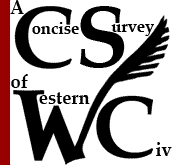Art History for Chapter 7:
From Old Rome to the New West: The Early Middle Ages, A.D. 500 to 1000
EARLY MEDIEVAL ART
After the German Barbarians fled Roman cities for the countryside, they produced little High Art for several centuries. The lack of high art in the Early Middle Ages is largely due to the economic collapse caused by the fall of the western half of the Roman Empire. A rich civilization can support great art. The barbarian kings lacked the resources to produce much art. Briefly the reign of Charlemagne indicated a hopeful rise in culture. Yet, the collapse of the Carolingian empire pushed back artistic efforts.
Painting/Graphic Arts
Very few graphic arts survive. If frescoes were painted, they were often later destroyed (but sometimes merely covered up and so can be somewhat restored). Some beautiful manuscripts reflect a great deal of creativity and effort. With the Carolingian Renaissance and its increase of learning, manuscripts increased in number and beauty, and the writing improved due to Carolingian minuscule.
Sculpture
The new barbarian rulers particularly valued jewelry and every-day objects made with great care and attention to detail, usually laid out with animal motifs or ornate patterns and knots. Gold inlaid with precious stones, especially garnet, became buckles, brooches, belts, sword hilts, drinking vessels. Many of these survive because they were buried with their dead noble owners and later excavated by archeologists, such as at Sutton Hoo in southern England.
Architecture
The lack of economic resources and the early barbarian dislike of cities meant they built little permanent architecture. Only a few Dark Age churches remain, since later tastes changed and successors could afford to build bigger and better (they thought) churches. The ruins of Rome in the West and the bright remnants of Ravenna would help to inspire Charlemagne to build a new capital for himself at his favoriet spa, his own “New Rome” of Aachen (or Aix la-chapelle). As Christendom slowly recovered from invasions, stone churches, especially for monasteries, became more numerous.
 At the end of the Dark Ages, the construction of castles provided security for slow recovery of Christendom.
At the end of the Dark Ages, the construction of castles provided security for slow recovery of Christendom.



